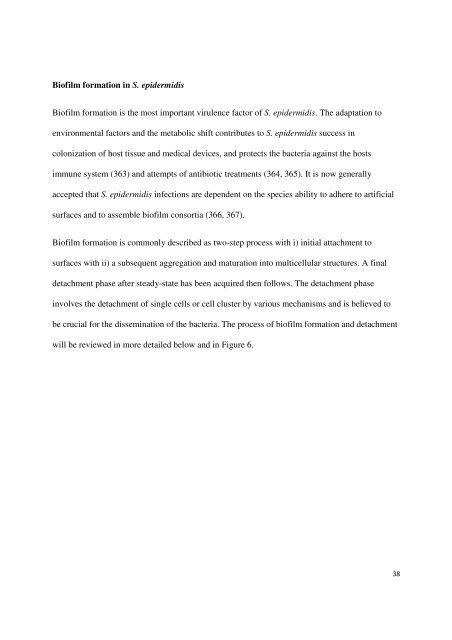Staphylococcus epidermidis - virulence factors and innate ... - Munin
Staphylococcus epidermidis - virulence factors and innate ... - Munin
Staphylococcus epidermidis - virulence factors and innate ... - Munin
You also want an ePaper? Increase the reach of your titles
YUMPU automatically turns print PDFs into web optimized ePapers that Google loves.
Biofilm formation in S. <strong>epidermidis</strong><br />
Biofilm formation is the most important <strong>virulence</strong> factor of S. <strong>epidermidis</strong>. The adaptation to<br />
environmental <strong>factors</strong> <strong>and</strong> the metabolic shift contributes to S. <strong>epidermidis</strong> success in<br />
colonization of host tissue <strong>and</strong> medical devices, <strong>and</strong> protects the bacteria against the hosts<br />
immune system (363) <strong>and</strong> attempts of antibiotic treatments (364, 365). It is now generally<br />
accepted that S. <strong>epidermidis</strong> infections are dependent on the species ability to adhere to artificial<br />
surfaces <strong>and</strong> to assemble biofilm consortia (366, 367).<br />
Biofilm formation is commonly described as two-step process with i) initial attachment to<br />
surfaces with ii) a subsequent aggregation <strong>and</strong> maturation into multicellular structures. A final<br />
detachment phase after steady-state has been acquired then follows. The detachment phase<br />
involves the detachment of single cells or cell cluster by various mechanisms <strong>and</strong> is believed to<br />
be crucial for the dissemination of the bacteria. The process of biofilm formation <strong>and</strong> detachment<br />
will be reviewed in more detailed below <strong>and</strong> in Figure 6.<br />
38
















